Yes, a Big Mac meal costs $18. But there is one good reason.

If you want to gauge Americans’ continued frustration with post-pandemic price increases, look no further than McDonald’s menu.
On social media, you can find complaints about $5 chicken sandwiches, $3 hashbrowns and $5.50 Egg McMuffins, all of which some customers said were too expensive for a place known for cheap fast food.
The cost of a meal at a classic burger chain reached $18 at one location. That’s the price you’d pay for a Big Mac combo meal at a rest stop in the wealthy town of Darien, Connecticut.
In New York City, the same Big Mac, medium fries, and medium soda combo sells for $13.89 on DoorDash, not including fees or delivery charges. Converting a soda to a shake costs $17.79.
However, these costs have increased so rapidly that McDonald’s MCD;
CEO Chris Kempczinski said on the company’s earnings call this week that it was having trouble attracting low-income customers. At least there may be hope for those working behind the counter.
A few months ago, the most important factor driving up fast food prices was the rising cost of the food itself. The biggest driver now is labor costs, said Eric Gonzalez, senior restaurant industry analyst at KeyBanc Capital Markets. In other words, McDonald’s employees are making more money than before.
“Probably a year and a half ago we would have been talking about food (cost). But food inflation seems to have become much more manageable,” he said. “Labor inflation is sticky.”
While this may be difficult for company leaders, it’s good news for employees in some of the job market’s most notoriously low-paying roles. The average hourly wage for fast food or counter workers in the U.S. was $13.53 in 2022, according to the Bureau of Labor Statistics. For a full-time worker, that comes out to about $27,000 per year.
“The reason McDonald’s is so cheap is because they pay too little for labor,” Washington State University economist Christopher Clarke said in a TikTok video examining rising restaurant prices. “Most of the increases in fast food prices are falling on workers.”
A McDonald’s spokesperson told MarketWatch that pricing decisions are at the franchisee’s discretion and therefore vary by location.
“Offering affordable options for our customers has always been at the core of our brand,” McDonald’s CFO Ian Borden said during the company’s fourth-quarter earnings call. “This is even more important as consumers feel pressured to spend.”
How much are fast food wages rising?
Wages for restaurant workers are rising, faster than wages in other sectors of the economy.
Hourly wages for workers in limited-service restaurants increased 26% between 2019 and 2022, according to data from the Bureau of Labor Statistics. In contrast, wages across the economy grew only about 17% over that period.
“This is absolutely a win for low-wage workers,” Clarke, the Washington State University economist, told MarketWatch. “We haven’t seen anything like this in 40 years.”
Low-wage workers in general have seen historic wage growth in the years since the pandemic.
Brian Haber, a restaurant industry analyst at Morgan Stanley, said that with the current relatively strong job market, this upward wage pressure is unlikely to go away anytime soon.
“When unemployment is this low, it continues to put pressure on wages in general, especially the minimum wage,” he said.
Fast food workers remain among the lowest paid workers in the economy, and in some states they can still earn the federal minimum wage of $7.25 per hour.
According to the National Low Income Housing Coalition, there are only about 16 counties across the U.S. where an employee working 40 hours a week at that wage could afford a one-bedroom rental at fair market rent.
Some states require employers to pay much more than the federal minimum. In California, fast food restaurants with more than 60 locations in the U.S. will be required to pay their employees at least $20 an hour starting in April.
McDonald’s will increase hourly wages at more than 90% of its U.S. company-owned stores in 2022, resulting in an 8% increase in average hourly wages, a company spokesperson told MarketWatch. This was the result of a 2021 effort to increase wages at company-owned restaurants by an average of 10%.
Other costs putting pressure on fast food profit margins include the still high cost of ingredients. Although the size of that burden depends on the type of food served, KeyBanc’s Gonzalez said. Construction delays and other obstacles to building new restaurant locations are also weighing on the chain’s profits.
“It has been difficult to build units over the past few years,” he said. “It’s still like that.”
Will McDonald’s lower its prices?
The higher wages workers are receiving may be cold comfort to anyone who recently paid close to $20 for a fast food meal, but for price-sensitive customers, there may be good news on the horizon.
Consumers overall appear to be rejecting fast food price increases, which may lead some brands to start offering better prices, analysts said.
The gap between the cost of cooking at home and the cost of eating out or ordering in is growing, reducing sales across the fast food industry.
These days, it’s about five times more expensive to eat outside the home than to stay in, Gonzalez said.
“As that gap grows, the operating environment generally becomes more difficult (for restaurants),” he said.
Kempczinski acknowledged on Monday’s earnings call that McDonald’s is having trouble attracting customers on tight budgets.
“The battleground is clearly low-income consumers,” he told investors and analysts. “What you’re going to see as we head into 2024 is probably more attention to the economics that I would describe.”
Consumers seem to be more interested in the absolute price of individual menu items rather than a combo deal that sells two items for $6, Kempczinski said.
That means you may soon see cheaper options on menus at McDonald’s and similar restaurants, Gonzalez said. This is because restaurants offer items or deals to attract more customers.
“Affordable entry-level price points is something we can start to emphasize,” Gonzalez said.
How has rising prices affected your life, and what do you think about the U.S. economy? please let us know readerstories@marketwatch.com. One of our reporters may contact you to find out more.




